|
The
business was established by Noah Hingley
in 1820. He was born in
1796 to Isaac and Esther Hingley and
became a chain maker, working in a small
factory on the banks of the River Stour.
In June 1833 he married Anne Wittingham
from Liverpool.
By 1838 he was a successful chain maker,
but was determined to manufacture large
anchors. Initially he could only forge
anchors weighing less than 20cwt. But
thanks to his introduction of the
Nasmyth steam hammer to the Black
Country in 1848, he was able to forge much
larger anchors and supply anchors with
an appropriate length of chain.
|
|
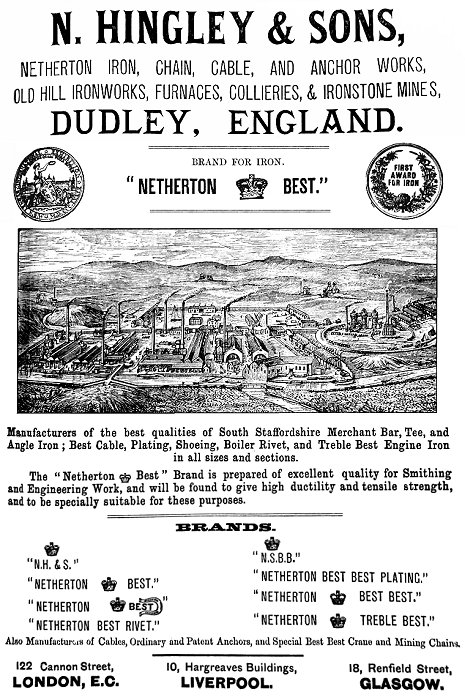
An advert from
1881. |
He also wanted to produce his own
iron and in about 1850 erected a large
ironworks at Netherton, by the Dudley No.
2 canal.
The firm also acquired coal
mines at Old Hill, Dudley Wood and
Coombs Hill, as well as the Harts Hill
Iron Works and the Old Hill Furnaces.
In 1856, Hingleys supplied towing
chain for boats on the Seine, as well as
20 miles of towing chain for use on the
River Neckar. In the following year the
firm produced an immense cable for the
steam ship Adriatic, which was 40 yards
long with each link weighing 50lbs.
At
the time, work was in progress on a chain
cable for the Great Eastern with even
stronger links, which was possible
because Hingleys
had installed one of the most powerful
hydraulic engines in the country, to bend
iron.
The firm produced anchors and chains
for some of the largest ships, including
the Lusitania, the Mauritania, the
Aquitania, the Olympic, the Columbus,
the Imperator, the Vaterland, the
Bismarck, the Titanic, and more recently
the Statendam. |
|

The factory in
1881. |
| By 1861 Hingley employed around 1,000
men and boys. At the time he was living
at Chapel House, Cradley
with his wife Ann Hingley and their
children, Mary, Joseph, Leah, Samuel and
Benjamin, along with three servants.
By 1863, the firm had 4 blast
furnaces. In 1865 his son Benjamin
became one of the managers at the firm,
which by that time was one of the
country’s leading manufacturers of
chain, producing over 10,000 tons
annually. Noah Hingley was Mayor of Dudley in
1869 and 1870 and his son Benjamin was
mayor in 1887 to 1888. Noah was also a
county and borough JP
and an alderman of the borough of
Dudley.
In 1871 the Hingley
family lived at Hawthorn Lodge, Windmill
Hill, Cradley. They are listed in the
1871 census as Noah Hingley, age 74;
Anne Linta Hingley, age 73; Benjamin
Hingley, age 41; Leah Hingley, age 40,
and two servants.
Noah Hingley died at
home, on the 21st October, 1877. His
funeral took place five days later at
Halesowen Parish Church, where he was
buried in the family vault. Around 2,000
employees of the company headed the
funeral procession which included the
Mayor of Dudley and twenty four members
of the Corporation, travelling in nine
private carriages. The procession was
nearly a mile in length.
|
|
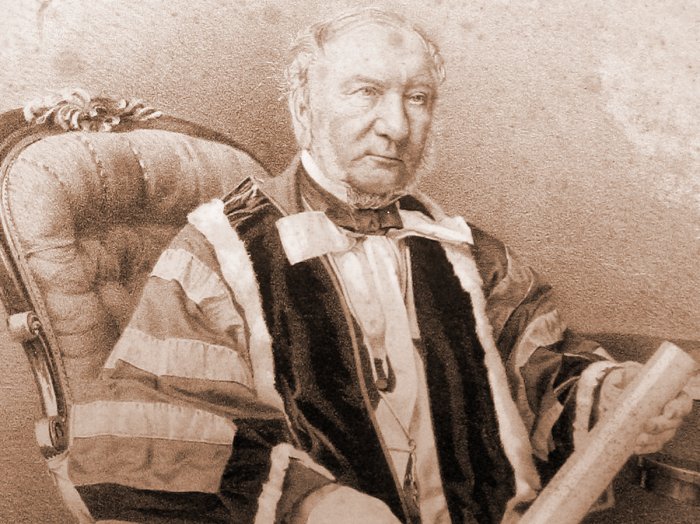
Noah Hingley in
his mayoral robe. |
| After Noah’s death,
his son,
Benjamin Hingley became head of
the business, which struggled a little in
the depression in the ship building
industry between 1876 and 1886. The
writer, William Curzon, gave a detailed
description of the company's works in
the early 1880s, stating that the
company could annually produce over
36,000 tons of pig iron, 60,000 tons of
finished bar iron and 10,000 tons of
anchors and chain. By 1885 the firm
employed around 3,000 people. In 1890, the firm became a public
limited company with the majority of the
shares being held by members of the
Hingley family. The firm became the sole
manufacturer of Hall's patent anchor in
1891 and supplied versions to many of
the great ocean going ships of the day. Further acquisitions followed. In
1893 the company acquired Manor Mines,
in Halesowen and in 1905 purchased
mines at Netherton from the
Earl of Dudley.
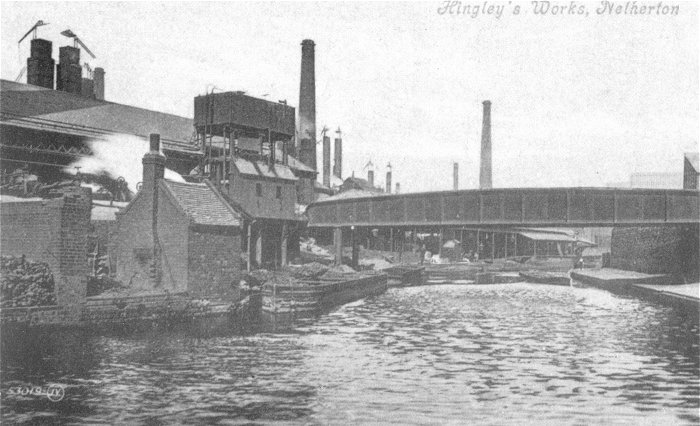
Hingley's factory
in the early 1900s. From an old
postcard.
On the 13th May, 1905,
Benjamin Hingley died at the age of 74
at Hatherton Lodge, Cradley and was
buried at Halesowen parish churchyard.
He had been Chairman of the South
Staffordshire and East Worcestershire
Ironmasters Association and President of
the Midland Iron and Steel Wages Board
and the South Staffordshire Coal
Trade Wages Board. He was elected as
Member of Parliament for North
Worcestershire in 1885 and became a
Liberal Unionist in 1886. He returned to
the Liberal Party in 1892 and held the
seat until the 1895 general election,
when he retired through ill-health.
He was an alderman of Dudley and
Mayor of Dudley from 1887 to 1889 and
county alderman for Staffordshire from
1889 to 1892. He was created a baronet
on the 8th August, 1893 and was also a
JP for Dudley, Worcestershire and
Staffordshire. In 1900 he became High
Sheriff of Worcestershire and a deputy
lieutenant of the county. In 1903, he
was elected president of the Mining
Association of Great Britain.
|
|

Puddling iron at
the ironworks. |
| In 1907, Frederick Simms, who owned
chainmakers G. Hartshorne and Company,
joined the business as did Cyril Edward
Lloyd, who became a director. He was a
member of the Lloyd family who ran F. H.
Lloyd & Company Limited, based at James
Bridge Foundry.
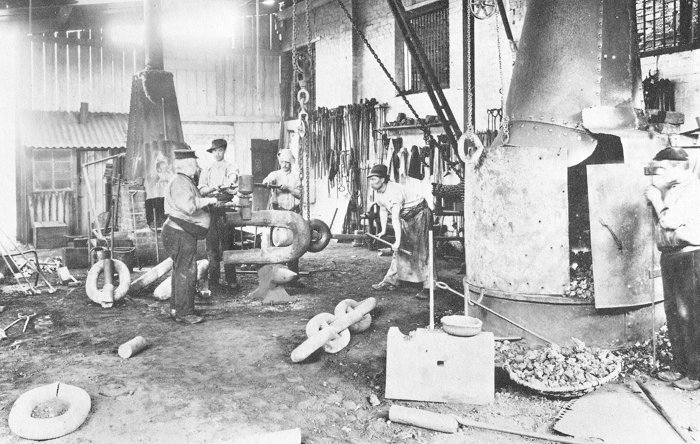
Making a large
chain at the factory in 1910. From an
old postcard.
In August 1910, the firm produced the
largest anchor ever made, weighing 15
tons 5¼ cwt for the White Star liner,
Olympic. It was 19ft long and 10 ft
wide. The following year the firm
produced the anchors and chain for the
Titanic. The largest of the anchors
weighed 15.5 tons and was drawn through
the streets of Netherton on a wagon
drawn by 20 shire horses.
|
|
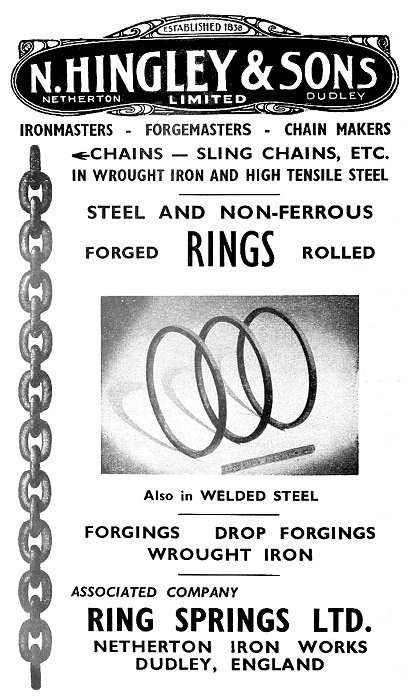
An advert from
1957. |
In 1914 the firm acquired Samuel
Taylor and Sons (Brierley Hill) Limited
and in 1918 Cyril Lloyd became chairman
of the board, a position he held until
1960. Hingleys acquired many other
businesses including John Bradley and
Company (Stourbridge) Limited and E. Baylie and Company Limited's Chain Works,
at Stourbridge in 1920.
In 1922 John Bagnall and Sons Limited, in Wednesbury,
and the Harts Hill Iron Company Limited
were acquired along with Joseph Wright
and Company.
More acquisitions included
B. Perkins and Sons Limited, at the Audnam Anchor Works, Stourbridge, and
Henry Wood and Company Limited of
Saltney, followed in 1927 by Midland and
Coast Canal Carriers, Limited, Broad
Street, Wolverhampton.
H. P. Parkes and
Company Limited of Tipton was acquired
in 1930 and Wright's Forge and
Engineering Company was purchased in
1947.
|
| In 1948 there was a large public
issue of shares.
In 1957 the old Darlaston based
structural steel manufacturer E. C. & J.
Keay Limited was acquired as was
M. & W. Grazebrook of Netherton
Ironworks, in 1961. Cyril Edward
Lloyd, who retired from the board in
1960, died in 1963 at the age of 86. He
had been with Hingleys for 56 years.
By 1964, parts of the business were
operating satisfactorily, whereas others
were making a loss. In 1966 the business
was acquired by F. H. Lloyd & Company
Limited of James Bridge Foundry.
After a number of reorganisations,
take-overs and sell-offs, the Netherton-based
business, then called Wright Hingley,
closed in 1986. The site is now occupied
by an industrial estate called the
Washington Centre. |
 |
Return to the
previous page |
|